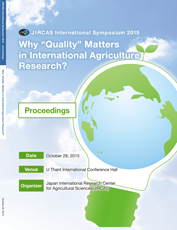A way to strengthen the role of cowpea in West Africa

In many African countries, there are many regionally and traditionally important crops such as sorghum, millet, yam, cowpea, banbara groundnuts, banana, and plantain, etc. They possess various unique characteristics that enable them to become suitable to regional and local environments and cultures; and they play crucial roles in the farm households. There are rational reasons for and advantages of cultivating those crops traditionally and continuously. These crops hold great potential to bolster the livelihoods of smallholder farmers and to benefit local communities in terms of household food security, nutritional supply, economic benefits, soil and cosystem health, cultural values, and diversification of regional agriculture systems.
Cowpea [Vigna unguiculata (L.) Walp.] is a major grain legume widely cultivated in most tropical regions around the world, especially in a wide range of agro-ecological zones in West Africa. The crop’s importance is attributed to its favorable characteristics such as tolerance to drought and low soil fertility, nitrogen (N)-fixing ability, and adaptability to different cropping systems, which provide resilience to the agricultural systems under severe and unstable growing environments of the region, particularly for small-scale farmers who have limited land and resources (Coulibaly and Lowenberg- DeBoer 2002) .
Also, as a grain legume with rich protein and micronutrient contents, cowpea can supplement staple crops (cereals and tubers) for more nutritionally balanced diets in this region. It serves as a key protein source, especially where consumption of animal proteins is precluded because of inaccessibility, poverty or dietary preferences. At the same time, it is also an important cash crop that help farmers meet required expenditures, such as for additional food, agricultural inputs, clothes, medications, school fees, etc. Sold cowpea grains greatly contributed to the regional economy via well-linked cowpea value chain in West Africa. According to FAO (2007-2009 data), cowpea generated an estimated 2 billion USD in annual revenue.
Although the yield factor remains as the primal target in our on-going cowpea breeding programs, "valueaddition" should also brought into the view for future development, focusing on the amplification of the roles and utilization of cowpea in rural livelihood and regional markets through enhanced income generation, food security and balanced nutritional supply in the region. Furthermore, cowpea's wide genetic diversity in various quality-related traits can be the key to value-addition in cowpea and its products that could meet various local preferences and cultural demands. However, the fundamental scientific information that form the basis for innovation generation and breeding strategies for value-addition in cowpea is currently lacking.
Realizing this challenge, JIRCAS has been implementing the "EDITS-Cowpea” project since 2011 in Nigeria, the world’s largest producer and consumer of cowpea, in collaboration with the International Institute of Tropical Agriculture (IITA), to generate the necessary scientific information and to provide more insights that will promote value-addition in cowpea improvement for the region. The project aims to 1) identify key characteristics with a view of improving grain quality and nutritional value, 2) select appropriate breeding materials for further improvement, 3) evaluate environmental factors affecting grain quality, and 4) develop useful techniques for rapid and simple evaluations of grain quality.
Under the project, we have identified wide genetic diversity in physical, nutritional/ antinutritional, and functional properties of cowpea grain, and found low associations among these properties (Muranaka et al. 2015). This finding suggests the possibility of introgressing favorable characteristics from the genetic resources to develop new varieties which match market and consumer preferences and enhance the nutritional and commercial values of the grain. In addition to the identified potential genetic resources, other scientific information obtained from the EDITS-Cowpea project, such as several developed tools for rapid evaluation of grain physical characteristics and protein contents; the suggested grain characteristics that influence market price; and the environmental factors that affect grain quality, will link the primal elements needed for grain quality improvement towards value-addition and facilitate the development of breeding strategies for value added cowpea.
In the near future, with the expected market expansion arising from economic growth in Africa, cowpea varieties that meet various demands and preferences of markets and consumers will be highly required. On the other hand, farmers will not select the variety even it has a high market price, if it is not equipped with suitable traits, and has low productivity and environmental adaptability to the target agriculture systems. To enable cowpea to respond to diverse requirements from various delivery destinations, JIRCAS is advancing its research activities on cowpea in order to strengthen the phenotyping capacity, which can be an important gateway to further large-scale exploration of useful genetic resources, effective selection in breeding procedure, and further development of molecular tools for breeding programs. It will eventually facilitate the dissemination of new suitable cowpea varieties and farmers' options, thus maximizing the productivity of the target environments and cropping systems.
Agricultural diversification and innovation should be defined and suited for each location to achieve sustainable production and food security. From this viewpoint, regionally important crops should be worthy of attention. Still, there is a large gap existing between the potential role of these crops and the low levels of investment they have received. The outputs of JIRCAS's collaborative researches on regionally and traditionally important crops are expected to advance our understanding for further development and utilization.
| Date of issued | |
|---|---|
| Creator | Satoru Muranaka Hiroko Takagi |
| Subject |
Regional crops cowpea genetic diversity quality value-addition |
| Publisher | Japan International Research Center for Agricultural Sciences |
| Available Online | |
| Issue | 2015 |
| spage | 74 |
| epage | 80 |
| Rights | Japan International Research Center for Agricultural Sciences |
| Language | eng |
